
Introduction
In the ever-evolving world of the building materials industry, packaging is more than just a means to an end -it's a pivotal factor in market success. As smaller packaging sizes begin to trend across various sectors, the question arises: What opportunities do 10-lb packages present for building material manufacturers? This article looks at the advantages, the economic considerations, and the practical applications of 10-lb packaging in the building materials sector.
Background: The Evolution of Packaging Sizes in the Building Materials Industry
Over the decades, the building materials industry has seen a steady shift in packaging design. In the past, large-volume bags dominated the market – since then, the needs of builders, craftsmen, and consumers have evolved. Lessons from other sectors, especially the food and consumer goods industries, suggest that smaller packages often correlate with convenience, quality, and value.
Advantages of 10-lb Packaging
-
Targeted Audience Appeal: 10-lb packages can cater both to individuals or smaller construction firms that don't require bulk quantities.
-
Convenience and Handling: For both the end consumer and the professional, they're easier to transport and store, enhancing purchase incentives. For tasks involving manual transportation and smaller quantity requirements, like renovating an apartment on the 5th floor, 10-lb packages are a game-changer.
-
Differentiation at Point of Sale: Amidst a shelf of large bags, a 10-lb package can really catch a buyer's eye. Moreover, a 10-lb bag can be designed to stand upright prominently on a shelf, enhancing product presentation.
-
Sustainability: Lighter packages are simpler to handle, reducing damage risks. This minimizes product wastage. Furthermore, smaller packages can be emptied more thoroughly, leaving less residue and reducing waste. The increased number of packages can be offset by using thinner, high-strength packaging materials that might otherwise remain unused.
-
Testing Opportunities: Introducing new products in smaller quantities can add in gaugeing market acceptance. Switch-ready craftsmen might be more inclined to try a new product in a smaller quantity.
-
Psychological Pricing: A higher price per pound is associated with superior quality, fostering a premium brand perception with the positioning of the smaller package size. Smaller packages always have a higher price per lb.
-
Perceived Quality: Packaging size can influence the perception of a product´s quality. A compact, well-designed bag can signify a top-tier product.
Economic Considerations
-
Pricing Strategy: With a 10-lb package, building material manufacturers can achieve higher margins, as consumers will often pay more for convenience and quality.
-
Production and Logistics Costs: While per-unit production costs might be higher, overall costs can be offset by increased sales and higher margins.
-
Market Introduction and Promotion: Smaller packages allow manufacturers to execute targeted marketing campaigns for product launches.
Case Study: The Old Building Renovation
Imagine being a craftsman tasked with renovating an old building in the heart of a bustling city. The building is on the 5th floor with no elevator. Every trip to the building is a test of strength. Enter the 10-lb packages.
Instead of lugging 55-lb bags up flights of stairs, multiple 10-lb bags can be transported with ease, reducing physical strain and boosting on-site efficiency. Moreover, the smaller packaging allows for more precise material dosing, which is especially beneficial for minor repair tasks like floor renovation or terrace repairs.
The result is a win-win for everyone! Satisfied clients, reduced physical exertion, and a more streamlined workflow benefit everyone involved.
Challenges and Considerations
Despite the plethora of advantages, introducing 10-lb packages can also present challenges, including production line adjustments, distributor feedback, and end-consumer acceptance.
Conclusion and Outlook
10-lb packages offer a promising avenue for building material manufacturers to differentiate themselves in a competitive market. With strategic planning and targeted marketing, these smaller packages can lead to increased sales and higher margins.

